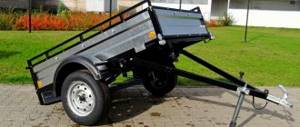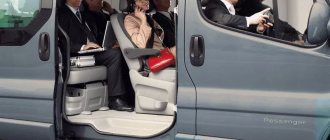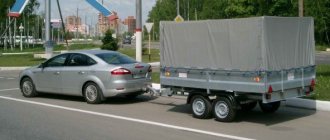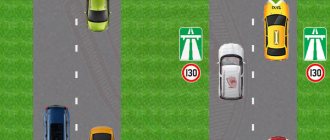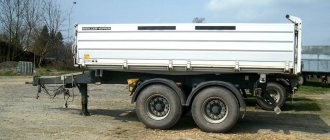To drive a car, you must have a driver's license with an open category corresponding to the type of vehicle. In some cases, it is sufficient for traveling by car with an attached trailer. However, there are a number of restrictions, in the presence of which it is necessary to open also subcategory “E”. Drivers with subcategory licenses “E to B”, “E to C” and “E to D” have all permissions to drive a car with any trailer, but what to do if they only have categories “B”, “C” or “D”?
When a trailer license is not needed
In paragraph 1 of Art. 25 of the Federal Law “On Road Safety” lists the criteria for admission to driving vehicles. The norm provides for cases in which it is permitted to connect with a trailer without a category “E” certificate. For drivers of passenger cars, the following situations are exceptions:
- if the total weight of the trailer does not exceed 750 kg;
- if the weight of the trailer is more than 750 kg, but less than the weight of the car without load, provided that the total composition is less than 3.5 tons.
The same article also considers cases in which a trailer is coupled to cargo and passenger vehicles. They do not require opening category “E” only when connecting a trailer with a gross weight of up to 750 kg.
Trailer, its types - official terminology
P . 1.2 The traffic rules define the concept of a trailer as follows:
“Trailer” is a vehicle that is not equipped with an engine and is intended to be driven in conjunction with a power-driven vehicle. The term also applies to semi-trailers and trailers.
Official terminology, depending on the technical characteristics of trailers, divides them into several types:
- light - are vehicles with a total weight not exceeding 750 kg;
- heavy - the total weight of the trailer is more than 750 kg, the package includes a brake mechanism;
- tractor - used as a towing vehicle for a passenger car.
What is the permissible weight of a trailer and how to find it out
The permissible weight of a trailer, also known as gross or maximum weight, is the sum of its actual weight with the permissible load capacity. This value is indicated in the corresponding column of the PTS and the registration certificate. It is this that is the main guideline for determining the need to open category “E”, taking into account the weight of the car for the bunch.
There are 4 weight categories of trailers:
- O1 – 750 kg;
- O2 – from 750 to 3500 kg;
- O3 – from 3.5 t to 10 t;
- O4 – over 10 tons.
A trailer belonging to category O1 can in any case be used by a driver with a license of category “B”, “C” or “D”, regardless of the weight of the vehicle itself. Heavier O2 trailers almost always need to be driven by a driver with an "E" license, although there are exceptions for a "B" license. They allow you to drive a vehicle or road train if the vehicle itself is heavier than the trailer, and together they fit into the weight limit of 3.5 tons. For such an exception, category “B” is sufficient. Heavier O3 and O4 trailers require “CE”, “DE”, “C1E” and “D1E” licenses.
Explanation of categories
Categories “B”, “C” and “D” allow you to drive vehicles of all categories that can be coupled to a trailer with a maximum weight of no more than 750 kilograms.
If this condition is not met, then motorists need to open new driving categories, respectively “BE”, “CE” and “DE”. For licenses with the letter “B”, another option is provided, the car is coupled to a trailer, the permitted maximum weight is over 750 kilograms, but not more than the weight of the car without load, while the total weight of the vehicle should not exceed 3500 kilograms.
Examples of calculations to determine the required category of rights
For a better understanding, consider a table with examples of calculations based on the weight of a trailer and a car.
| Machine weight, kg | Trailer weight, kg | Required category of rights | Explanation of calculations |
| 720 | 750 | B | The trailer belongs to category O1. |
| 1250 | 1050 | B | Although the trailer belongs to the O2 category, it is lighter than a car. Together they do not exceed 3.5 tons. |
| 950 | 1050 | BE | The car is lighter than an O2 category trailer. |
| 3100 | 850 | BE | Although the O2 trailer is lighter, together with the vehicle they exceed 3.5 tons. |
| 3100 | 740 | B | The trailer weighs less than 750 kg. |
| 1950 | 2100 | BE | The trailer is heavier, and together with the car they exceed 3.5 tons. |
| Machine weight (kg) | 720 |
| Trailer weight (kg) | 750 |
| Category of rights | B |
| Explanation of calculations | The trailer belongs to category O1. |
| Machine weight (kg) | 1250 |
| Trailer weight (kg) | 1050 |
| Category of rights | B |
| Explanation of calculations | Although the trailer belongs to the O2 category, it is lighter than a car. Together they do not exceed 3.5 tons. |
| Machine weight (kg) | 950 |
| Trailer weight (kg) | 1050 |
| Category of rights | BE |
| Explanation of calculations | The car is lighter than an O2 category trailer. |
| Machine weight (kg) | 3100 |
| Trailer weight (kg) | 850 |
| Category of rights | BE |
| Explanation of calculations | Although the O2 trailer is lighter, together with the vehicle they exceed 3.5 tons. |
| Machine weight (kg) | 3100 |
| Trailer weight (kg) | 740 |
| Category of rights | B |
| Explanation of calculations | The trailer weighs less than 750 kg. |
| Machine weight (kg) | 1950 |
| Trailer weight (kg) | 2100 |
| Category of rights | BE |
| Explanation of calculations | The trailer is heavier, and together with the car they exceed 3.5 tons. |
Carrying out calculations does not require complex mathematical calculations, so everyone can handle them. It is necessary to take into account that State Traffic Inspectorate employees check drivers of cars with a trailer to ensure that they have the necessary category of driving license. To do this, you will need to provide a driver’s license and a certificate of registration of the car and trailer at the request of the traffic police officer.
General questions about trailers
A passenger trailer is an excellent purchase, which greatly facilitates the transportation of goods for its owner, but at the same time requires increased attention and responsibility from him. If you have become the proud owner of a passenger trailer, we recommend that you refresh your mind about the “Rules of the Road”.
In this article, we tried to collect for you all the points of the traffic rules that directly relate to the operation and movement of a car with a trailer. Compliance with these rules will make your trip safe and protect you from problems on the road, as well as avoid unpleasant communication with traffic police inspectors.
Section 1 “General Provisions” defines basic concepts and terms that will help us understand which points of the rules relate to the operation of a car with a trailer.
1.2. The Rules use the following basic concepts and terms:
- A road train is a mechanical vehicle coupled to a trailer(s).
- A trailer is a vehicle that is not equipped with an engine and is intended to be driven in conjunction with a power-driven vehicle. The term also applies to semi-trailers and trailers.
- A motor vehicle is a vehicle driven by an engine. The term also applies to any tractors and self-propelled machines.
- Vehicle is a device designed to transport people, goods or equipment installed on it on roads.
Section 2, General Duties of Drivers, sets out and explains the responsibilities of drivers, including ensuring the safe operation of a vehicle and trailer.
2.1. The driver of a motor vehicle is obliged to:
2.1.1. Carry with you and, upon request, hand over to police officers for inspection:
- a driver's license or temporary permit to drive a vehicle of the appropriate category or subcategory;
- registration documents for this vehicle (except for mopeds), and if there is a trailer, also for the trailer (except for trailers for mopeds);
2.2. The driver of a motor vehicle participating in international road traffic is obliged to:
- - have with you and, at the request of police officers, hand over to them for verification the registration documents for this vehicle (if there is a trailer - and for the trailer) and a driver’s license that comply with the Convention on Road Traffic, as well as documents provided for by the customs legislation of the Customs Union, with marks customs authorities confirming the temporary import of this vehicle (if there is a trailer - and a trailer);
- - have on this vehicle (if there is a trailer - and on the trailer) registration and distinctive signs of the state in which it is registered.
2.3. The driver of the vehicle is obliged to:
2.3.1. Before leaving, check and ensure that the vehicle is in good technical condition on the way in accordance with the Basic Regulations for the admission of vehicles to operation and the responsibilities of officials to ensure road safety.
It is prohibited to drive if there is a malfunction of the service brake system, steering, coupling device (as part of a road train), headlights and tail lights are not on (missing) in the dark or in conditions of insufficient visibility, the windshield wiper is not working on the driver's side during rain or snowfall.
Section 10 “Traffic speed” regulates the speed limit in various situations. Many drivers forget about it and drive along the highway in a car with a trailer at the usual speed (as without a trailer). When driving with a trailer, the rules require a different speed limit.
10.3. Movement outside populated areas is permitted:
- for other buses, cars when towing a trailer, trucks with a permissible maximum weight of more than 3.5 tons on highways - no more than 90 km/h, on other roads - no more than 70 km/h;
Section 19 “Use of external lighting devices and sound signals” requires the driver to:
19.1. In the dark and in conditions of insufficient visibility, regardless of the road lighting, as well as in tunnels, the following lighting devices must be turned on on a moving vehicle:
- on all motor vehicles - high or low beam headlights, on bicycles - headlights or lanterns, on horse-drawn carts - lanterns (if equipped);
- on trailers and towed motor vehicles - side lights.
Section 22 Transport of Persons prohibits the driver from transporting persons in a trailer.
22.8. It is prohibited to transport people:
- outside the cabin of a car (except for cases of transportation of people in the back of a truck with a flatbed or in a van), tractor, other self-propelled vehicles, on a cargo trailer, in a caravan trailer, in the back of a cargo motorcycle and outside the seating areas provided for by the design of the motorcycle;
Section 23 “Transportation of goods”. For drivers of cars with a trailer, this is one of the most important sections and you should treat it very carefully and follow its instructions.
23.1. The weight of the transported cargo and the load distribution along the axles must not exceed the values established by the manufacturer for this vehicle.
23.2. Before starting and while driving, the driver is obliged to control the placement, fastening and condition of the load in order to avoid it falling and creating obstacles to movement.
23.3. Transportation of cargo is permitted provided that it:
- does not limit the driver's visibility;
- does not complicate control and does not affect the stability of the vehicle;
- does not cover external lighting devices and reflectors, registration and identification marks, and does not interfere with the perception of hand signals;
- does not create noise, does not create dust and does not pollute the road or the environment.
If the condition and placement of the cargo do not meet the specified requirements, the driver is obliged to take measures to eliminate violations of the listed transportation rules or stop further movement.
23.4. A load protruding beyond the dimensions of the vehicle in front or behind by more than 1 m or on the side by more than 0.4 m from the outer edge of the side light must be marked with identification signs “Large load”, and in the dark and in conditions of poor visibility In addition, in front - a flashlight or a white reflector, at the back - a flashlight or a red reflector.
23.5. Transportation of heavy and dangerous goods, movement of a vehicle whose overall dimensions with or without cargo exceed 2.55 m in width (2.6 m for refrigerators and isothermal bodies), in height of 4 m from the surface of the roadway, in length (including one trailer) 20 m, or the movement of a vehicle with a load protruding beyond the rear point of the vehicle's overall dimensions by more than 2 m, as well as the movement of road trains with two or more trailers is carried out in accordance with special rules.
We would also like to draw your attention to the points in the appendix to the traffic rules “List of faults and conditions under which the operation of vehicles is prohibited.”
According to the application, it is prohibited to use the vehicle if:
7.6. The towing coupling and support coupling devices of the tractor and trailer link are faulty, and the safety cables (chains) provided for by their design are missing or faulty. There are gaps in the connections between the motorcycle frame and the side trailer frame.
7.18. Changes have been made to the design of the vehicle without permission from the State Road Safety Inspectorate of the Ministry of Internal Affairs of the Russian Federation or other bodies determined by the Government of the Russian Federation.
Please note that paragraph 7.18 was not included here by mistake, because based on the terms and concepts described in paragraph 1.2, a passenger trailer is a vehicle, therefore all changes in its design must be agreed upon with the relevant authorities.
The above rules have been published without changes and fully comply with the current edition of the traffic rules dated December 19, 2014.
Return to list
Responsibility for lack of rights of subcategory “E”
Illegal use of a vehicle in conjunction with a trailer in accordance with traffic regulations is punishable by law. It is the responsibility of every motorist using a trailer to ensure that he has the right to do so. If category “E” is required, then using a trailer in its absence is equivalent to driving without a license. According to Part 1 of Article 12.7 of the Administrative Code, such a violation entails liability in the form of a fine from 5 to 15 thousand rubles.
In addition to drawing up an administrative protocol, norm 27.12 of the Code of Administrative Offenses is applied to withhold a fine. She demands that the violation be stopped by removing the driver from the vehicle. The car itself with the trailer in accordance with Art. 27.13 Code of Administrative Offenses sent to the impound lot. Finding a car in a penalty area is accompanied by additional costs, which, depending on the region and duration of parking, can be equal to or exceed the amount of the fine itself. Thus, driving a car with a heavy trailer, the weight of which requires category “E”, is extremely undesirable.
Drivers may also be fined for overloading a trailer, so the lack of a suitable category of license may also result in it being weighed. When loading in excess of the permissible norm, Art. 12.21 of the Administrative Code, which provides for liability for violation of transportation and towing rules. It provides for a fine of 500 rubles.
Design specifics
Any vehicle must be registered no later than 10 days from the date of purchase. For registration, you can apply to any registration department of the traffic police, regardless of the applicant’s place of residence or region of stay.
The rules for registering trailers in 2021 are regulated by Decree of the Government of the Russian Federation dated December 21, 2019 No. 1764. Regardless of the number of axles, vehicles must be registered with the state traffic police authorities, while persons who have a driver’s license with an OSAGO do not need to purchase an additional OSAGO policy directly for it ( Clause 3, Article 4 of the Federal Law of April 25, 2002 N 40-FZ On Compulsory Motor Liability Insurance).
Permissible speed limit for vehicles with a trailer
It is worth noting that the traffic rules set certain speed limits only for passenger vehicles with a trailer. The following criteria are provided here:
- no more than 90 km/h for driving on a motorway;
- no higher than 70 km/h when traveling outside the populated area;
- no more than 60 km/h when driving within populated areas;
- no higher than 20 km/h when traveling within the coverage area of the “Residential zone” sign.
Also, a passenger car with a trailer cannot drive more than 20 km/h in courtyard areas. Motorists should take into account that we are talking specifically about passenger vehicles, and not in relation to category B.
For example, if a small truck (for example, a Gazelle) is traveling with a trailer, then the previously mentioned restrictions do not apply here. This car, as part of a road train, can travel along the highway at a speed of 110 km/h. Also outside the city in this situation, the Gazelle driver can accelerate to 90 km/h. The same rule applies to relatively small pickup trucks, which in appearance may resemble passenger vehicles. Here it is necessary to take into account that the restriction also does not apply to trucks, buses and other vehicles that can move at the maximum permissible speed, both without a trailer and as part of a road train.
No trailer driving sign
The traffic rules include a sign that prohibits driving with a trailer:
3.7 "Driving with a trailer is prohibited." It is prohibited to drive trucks and tractors with trailers of any type, as well as tow motor vehicles.
Please note that in this case we are also talking about the type of vehicle (truck or tractor), and not the category of the vehicle.
That is, this sign prohibits movement:
- Any trucks (categories B, C) with trailers.
- Any tractors with trailers.
- Towing of motor vehicles.
- The sign does not prohibit the movement of cars or buses with trailers.
How to get a category C license
In order to obtain a category C license, you must perform a number of actions:
- To begin with, a potential driver should go to a clinic to undergo the appropriate medical examination to obtain a driver's license to drive a category C vehicle with a trailer.
- After passing the medical examination and receiving the appropriate certificate, you must undergo training at a driving school. To do this, it is recommended to contact a special institution. It is worth noting that currently training in a driving school is paid, the duration of the training itself is about 4-6 months. This includes both practical and theoretical parts.
- Then you need to pass an exam at the traffic police. The exam tests knowledge of theory and practical skills on a special site and on the highway in the city. As for the theoretical part, it consists of 20 questions. In order to pass it successfully, you must answer at least 18 questions correctly. After the examinee has passed the theoretical part, he receives admission to the practical part at a special site. There he needs to successfully complete 3-4 exercises, which are prescribed by the examiner himself. Only after successfully completing all the exercises is a person allowed to drive in the city. After all stages have been completed without any comments, the exam is considered passed. And in order to get your coveted driver’s license, you need to pay the state fee.
Rules for preparing for the trip
An important feature of traveling with a trailer is its mandatory registration with the traffic police. Since it is a full-fledged vehicle, the rules provide for its operation only with vehicles equipped with towbars and plug sockets. External lights on the trailer must be in full working order.
To safely drive a car with a trailer, carefully check the condition of the trailer lock and the reliability of the safety chains and cables. Negligence when checking the technical condition is fraught with accidents and administrative liability under Art. COAP 12.5 “Driving a vehicle in the presence of malfunctions.” The punishment for the first violation is a warning, and for subsequent violations a fine of 500 rubles is imposed. and even the detention of a vehicle.



